31
December 2002
Six
Little
Dabchicks (=Little Grebes) are spotted
repeatedly diving beneath the flooded Widewater
Lagoon.
Report
by Peter Talbot-Elsden
There
is a complete absence of gulls
on the playing fields and parks of Shoreham in contrast to five
days before.
27
December 2002
Straight
as an arrow, the Kingfisher
flew the the length of the stream by Adur Metal Works, just over over a
metre above the surface of the contaminated water, the turquoise showing
for the complete length of the sudden flight under the doctored branches
of surviving Monterey Cypresses (TQ 210 053).
The
Little
Egret on the adjacent mud flats looked
to be very slender and to have a much finer beak than normal. Maybe, it
was a juvenile bird probing in the shallows at half tide.
26
December 2002
On
the edge of Widewater Lagoon, a Kestrel
took a Goldfinch
in mid-flight, hard enough to down the bird before finally capturing it.
 Hundreds
of gulls filled the air and covered the sodden school playing fields and
green grass of the parks, totalling thousands. It seems that there are
more than usual at this time of the year: Black-headed
Gulls, with striking red legs (probably
a different population than the summer resident gulls) make up the
bulk of the influx, but there were scores, totalling hundreds of Herring
Gulls, both mature and immature. Many
of the gulls were "paddling" for worms. The
mud flats at half tide opposite the airport were denuded of gulls and six
Grey
Plovers were the largest birds, feeding
at the water's edge on a breezy overcast day. Hundreds
of gulls filled the air and covered the sodden school playing fields and
green grass of the parks, totalling thousands. It seems that there are
more than usual at this time of the year: Black-headed
Gulls, with striking red legs (probably
a different population than the summer resident gulls) make up the
bulk of the influx, but there were scores, totalling hundreds of Herring
Gulls, both mature and immature. Many
of the gulls were "paddling" for worms. The
mud flats at half tide opposite the airport were denuded of gulls and six
Grey
Plovers were the largest birds, feeding
at the water's edge on a breezy overcast day.
25
December 2002
The Sparrowhawk
returned to my Eastbrook Road, south Portslade, East Sussex, garden on
Christmas morning. The large rose in the right hand corner at the back
of the garden are a meeting point for sparrows entering ours and two other
adjacent gardens. The sparrows rushed to the centre of the bushes and the
Sparrowhawk
swooped down and landed on the bird table. It then flew around the rose
bush and forced its way through the branches taking a sparrow with it.
As we have now been feeding the birds at this point, more birds were present
than the last time.

Sparrowhawk
The Sparrowhawk
hooded its prey on the ground behind the buddleia and after a few minutes
it started to pluck the sparrow. About half an hour later, when we were
ready to leave I checked the hawk and it was still busy eating. I was just
about to leave when I saw a large cat drop from the wall onto the Sparrowhawk,
unfortunately most of the scene was hidden behind the buddleia but flapping
of wings and flashes of white fur were visible. After what was probably
only a few seconds the hawk broke free and managed to clear the garden
wall, the cat sniffed around where the hawk was and did not find the sparrow
so the hawk must have managed to take it with it.
Full
Report
Other
Sparrowhawk Reports
23
December 2002
Six Brent
Geese were feeding on the flooded airfield.
Five of them had dark breasts, and a sixth one was lighter in colour. The
sky was black with hundreds of Lapwings.
December
2002
There
have been repeated reports of a Grey Heron
by the roundabout underneath the flyover north of Old Shoreham, and even
on one occasion of the bird landing on the concrete slipways leading to
the main A27 trunk road.
Report
by Helen Swyer and others
22
December 2002
A
brisk walk around Brooklands Lake, east Worthing, produced a single sighting
of a Grey Wagtail
as well as the usual collection of Pochard,
Coots, Moorhen and Mallard
Ducks.
20
December 2002
Cycling
east over the Toll
Bridge I turned south at the downslink junction. At this point a pedestrian
50 metres in front of me flushed out a bird which flew up the path towards
me in a low swooping fashion. Having time to focus my eyes as it flew past
following the path northwards I recognised it to be a Kingfisher.
The vivid turquoise shine on it's back as it travelled north was a glimmer
of brightness on an otherwise overcast day. Continuing southward along
the track nest to the river I spotted solitary diving duck. Further down
in the shallows a Little
Egret was fishing, it allowed me to come
quite close to it but to my chagrin I did not have a camera with me.
Next
stop was Widewater
Lagoon, leaving the A259 coast road I crossed the footbridge over the
lagoon to see another Little Egret
fishing but this one was more timid and I could not get close.
A
quick look over at the rock groynes I spied an Oystercatcher
perched on the boulders. On an unusually deserted promenade I flushed out
a group of charming Goldfinches
and some very raucous Sparrows.
The
Kingfisher was
also spotted by Helen Swyer,
who followed it as it came to rest on the remains of the rotting boat on
the east side of the river.
With
the Adur on a high spring tide as still as a mill pond, a Red-breasted
Merganser dived beneath the milky waters
just south of the Toll Bridge.
As
it was high tide the hundreds of Lapwings
were on the airport grass.
I
noted that the half a dozen
Meadow Pipits on the cycle path and airport
showed their tail underwing as a very distinctive bright white in contrast
to their rich chocolate brown speckled breasts.
NB:
So different (thrush-like) were these pipits from the local pipits in the
fields, e.g. on New Monk's Farm, and so pronounced were the white outer
tail weathers in contrast to the dark other feathers, that I do not think
that these are local pipits but migrant birds moving south. My favourite
choice is a Meadow Pipit that has recently moulted.
Meadow Pipits are reported to undergo a partial moult in the first three
months of the year. Some books make a distinction based on colour and the
darkest birds are known as whistleri and are meant to be found in
Ireland and western Scotland. These may be known as thereas in earlier
books and these are the darkest of the Meadow Pipits. The thereas plumage
distinction is now thought not to be distinct enough to warrant separation.
Ref:
British Larks, Pipits and Wagtails (by Eric Simms NN 1992).
On
the edge of Widewater,
a Feral Pigeon
probed. This "townie" is locally uncommon (except for Southwick Square),
no longer even found regularly at the railway stations in the Adur urban
district. On the sparsely vegetated artificial
island of Widewater Lagoon, a Great
Black-backed Gull was doing its best to
further denude the vegetation with a large (rabbit-sized) clump of greenery
in its beak, with which it flew off.
The
Tamarisk
provided shelter for a small chirm of a half dozen Goldfinches.
Pied Wagtails
were common in the town on the roads and on the shingle beach.
16
December 2002
It
was a eerily still and quiet on a misty Lancing
Clump in the late afternoon, Ash and Beech had a wintery
look festooned with glossy green Ivy,
Hedera helix, and twining Old Man's
Beard, Clematis vitalba, with the
fungi disintegrating and being resorbed into the woodland soil beneath
the leaf litter.
On
the way out past the dewpond
(TQ 181 065), a flash of yellow and green
tail feathers caught my eye. As the large Jackdaw sized bird flew towards
the pond I could make
out its appearance as a Green
Woodpecker. Two species of woodpecker,
Green,
Picus
viridis, and Spotted,
Dendrocopus
sp., are known on the clump but not frequently seen.
Three
Long-tailed
Tits are exploring the large eight metre
high Hawthorn Tree
at the bottom of my back garden, in south Lancing (TQ
186 044).
Friends
of Lancing Ring
14
December 2002
The
first visit of a Pied Wagtail, Motacilla
alba yarrelli, to my back garden,
in south Lancing (TQ 186 044),
to feed on the ground. This bird is common on the residential roads and
green open spaces but rarely ventures into the relatively confined spaces
of garden territory. It was a very damp and
murky day but at 8° C
it was a bit warmer than the last couple of near freezing days.
At
1:30
pm a farmer and his dog flushed four Snipe
from
the rushes on the west bank of the stream that runs from the New Salts
Farm Road railway bridge to the dog kennels (TQ
205 048). The birds headed north over the
airport. This long beaked bird is now mainly a winter visitor only.
12
December 2002
A
flick of the white, or grey, outer tail feathers as I think it was a Meadow
Pipit that flew between the beach huts
to the new rock groynes on the shingle beach at Lancing (TQ
204 042) adjacent to the east end of the flooded
Widewater Lagoon. My identification was based mainly on the repeated call
as it flew away. Could
it have been a Water Pipit? or
a Rock Pipit?
Trouble
with Pipits Identification
Rock
and Water Pipits (Identification Hints)
Rock
& Water Pipits Messages
10
December 2002

Hedgehog
in our South Lancing garden
(TQ
186 044)
Photograph
by Jan Hamblett
In
the near freezing (3° C)
temperatures and with bitter chill breeze (Force
4, wind chill -1° C) from the north-east,
a Hedgehog
was still out and about and made a visit to the wildlife pond in our south
Lancing garden. (TQ 186 044)
Shoreham
Beach Weather
UK
Wildlife Gardening Yahoo Group
6 December
2002
A black sea bird was resting
on the sea off the beach adjacent to Widewater Lagoon.
In the swell it was being carried into about 20 metres from the shingle
beach on a high spring tide. It was almost certainly an injured
Razorbill.
2 December
2002
The
Long
tailed Tits,
Aegithalos caudatus,
have returned as winter visitors to my Shermanbury garden.
Upper
Adur East (Shermanbury area) Nature Pages
South
Downs Way (by Allen Pollard)
30
November 2002
The
albino/leucistic (white-winged) Magpie is seen again. This time I saw
it very clearly in the small trees bordering the Adur estuary
between the Norfolk Bridge and the houseboats (TQ
210 047), opposite (east side of) Adur Recreation
Ground.
Previous
Report
A
Black
Redstart
is
playing on the new syenite rock sea defences erected/deposited on the beach
side of Widewater near the beach huts.
Rock
Sea Defences 2002
Lancing
Wildlife & History Discussion Group
26
November 2002
On
the small area of exposed mudflats (TQ 2105
0530) just north of the Railway Viaduct spanning
the Adur at Shoreham, about 250 Lapwing
roosted with three more energetic Grey
Plover probing the mud, as the light faded
and the tide began to fall.
25
November 2002
The Peregrine
Falcon is perched half way up the Shoreham Harbour Power station chimney
(TQ
246 048) late this afternoon.
It seems to be permanently residing there, at least during the winter,
although it may have been disturbed by recent repair work. It has not been
seen feeding near the harbour, although there is a confirmed report of
a falcon feeding on pigeons of the West Pier, Brighton, and another recent
report of a Peregrine feeding on Southwick Hill.
A
local resident said that a nest box had been installed on both the new
and old (demolished) power station chimneys.
South
Coast Power Ltd confirmed that a nesting box had been installed and that
a pair of Peregrine Falcons had successfully reared two female chicks which
eventually flew off earlier in the year.
Nest
Box Link
Report
by Peter Talbot-Elsden
24
November 2002
The
usual Coot (44)
and Moorhen
(6) on Brooklands Boating Lake, east Worthing, were joined by 16 Pochard
and
one Shelduck.
On the adjacent pitch & putt course, a dozen Brent
Geese were chased off by dogs, the geese
flying east.
Up
the Coombes Road from Lancing College to Steyning this morning, I was shocked
to see masses
of thick hedgerows and trees being ripped out both along the roadside and
around the adjacent fields. A
stretch of at least 300 metres from Passies Pond to St. Botolphs Church
are in the process of being bulldozed along with most of the willows around
Passies Pond, what a sad sight..... and a right mess!
23
November 2002
A
quick view of a
Willow Tit, Parus montanus, (ID
was probably wrong?) fluttering
above the bushes on the northern margins of New Monks Farm, east Lancing,
near the weighbridge, (TQ 192 057),
to the west of Withy Patch, was my first recorded sighting of this bird
that I am unfamiliar with. The call
was very clear (second voice on the file) and different from
the similar Marsh Tit. The black tuft at the
rear of the black cap was noticeable (but not diagnostic as it also
present also in the Marsh Tit and to a certain extent in the Great Tit
as well). However, the Shoreham & District
Ornithological Society booklet describes the Willow
Tit as the rarest of the titmice in the local
area, but there is no longer any doubt about my identification of my fleeting
observation as I cycled past. This bird is
in rapid decline in most habitats since the 1970s. This titmouse favours
swampy wooded areas like the stroud
south of Withy Patch, where it can find and improve its favourite nest
sites of holes in rotten trees.
UK
Wildlife Discussion
Willow
Tit Register
Sussex
Ornithological Society Titmice
BTO
Status
Birdguides
Information Page
We
had a Sparrowhawk
in our south Portslade (Eastbrook Road) garden. I first spotted it on the
post of the bird table which had blown over. It then flew onto the wall,
so it was in clear view. The hawk was after the sparrows which had
taken cover deep in the rambling rose. It made several attempts to get
at the sparrows, which managed to keep out of the bird of prey's reach
and not break cover.
Full
Report
17
November 2002
Pochards
were seen on Brooklands Boating Lake, east Worthing.
An
adult winter Great Northern
Diver was seen at the eastern end of Shoreham
Harbour at 3:00 pm.
16
November 2002
Near
the Information Kiosk by Widewater Lagoon, two
uncommon Sussex birds made a brief visit: a single Black
Redstart
and a couple of Stonechats.
It is interesting how the Widewater provides a temporary haven for a large
variety of the less familiar birds. The identity of these birds were confirmed
by Sussex
Ornithological Society observers.
Lancing
Nature Newsletter (November 2002)
14
November 2002
An
extra Little
Egret was seen on the margins of Widewater
Lagoon. Not so little either, these two birds appeared as white herons
at first and the appearance of their size is dependent on their behaviour,
skulking around the margins makes them appear smaller. One bird seemed
to have such pronounced rings on its legs it appeared like it was in plaster.
 Then
a hailstone broke out on this squally day where a brief gale blew up and
in minutes the wind had reduced to a breeze. An example of the variation
is shown on the graph. Then
a hailstone broke out on this squally day where a brief gale blew up and
in minutes the wind had reduced to a breeze. An example of the variation
is shown on the graph.

Shoreham
Beach Weather
Beaufort
Scale
11
November 2002
The
Little
Egret is back feeding on in and around
Widewater
Lagoon after a break for the summer months.
Egret
Information Update
10
November 2002
In
the garden of 40 The Drive (near Buckingham Park), Shoreham-by-Sea, (TQ
219 063) at least eight Blackbirds
(seven male) were in the garden at one time as the rain fell steadily down.
The attraction was the bright red berries
of the small Holly Tree,
on which the Blackbirds
were obviously feeding, the bright red berries distinctive in their yellow
bills. the Blackbirds
were coming and going and there were more than eight birds in total taking
advantage of this food resource and having a look at the small garden pond
and bird bath. A Wren flew
out of the Holly Tree
as well.
Shoreham
Town & Gardens Wildlife page
Lancing
Clump was shrouded in a light mist, rain fell in intermittent bursts;
the woodland floor covered with fallen leaves, the trees almost bare after
the battering of recent gales. The atmosphere was heavy and sombre, the
weight of the woodland canopy all around the feet, ready to begin the process
of replenishing the soil. The recycling of dead timber was in evidence
with the fruiting of several clumps of fungi, including the Jews Ear
and the Shaggy and Golden Pholiotas.
Full
Report and Photographs
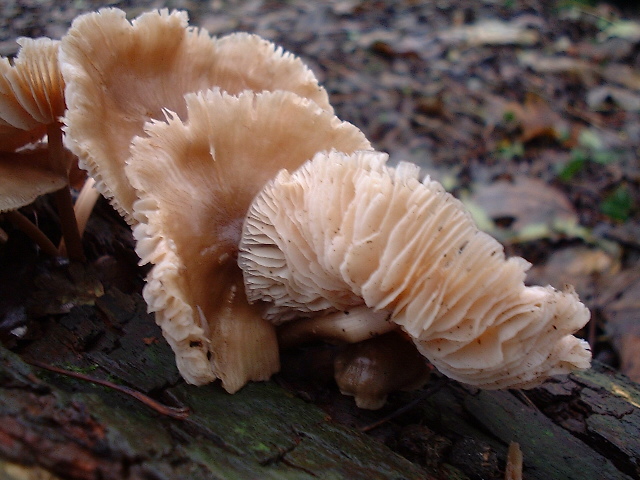
This mystery
mushroom is Mycena
inclina with a slender stem dark red-brown at the base, white
above and with a pleasant soapy or sweet smell.
GB
Checklist of Fungal Names
9 November
2002
A
Grey
Heron was perched on the second groyne
on Kingston Beach as the tide came in this morning.
A Kestrel
hovered over Middle Road Playing Fields, Shoreham.
7 November
2002
A
Red-breasted
Merganser dived under the water for its
diet of small fish between the Toll Bridge
and Railway Viaduct on the Adur estuary.
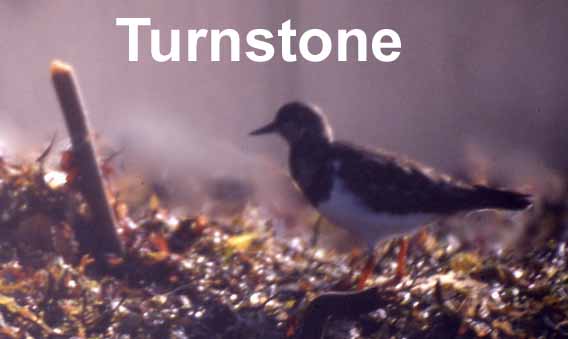
Near
the Old Fort (TQ 233 045),
Shoreham
beach, on the strandline to the west of
the harbour pier, five Turnstones
in black (actually dark brown) with grey-white breasts and distinctive
red legs and large feet, were foraging amongst the accumulated seaweed
and occasional dead Dogfish, seashells, broken fishing pots and single
dried out Mermaid's Purse (Thornback Ray).
The Turnstones could be seen
very clearly and closer than other waders, confident of their own camouflage
which was not nearly as efficient as that of the Ringed
Plover or Pied Wagtail, the commoner birds
of the shingle beach and strandline in the colder months. Then to my surprise
I disturbed a Red Admiral Butterfly
amongst the seaweed. The anglers were catching Whiting, Flounders and small
Bass
from the harbour arm.
5 November
2002
Late
Butterfly
A
fresh looking Small
Tortoiseshell Butterfly was
disturbed from under a clump of Honeysuckle as I mowed the lawn of a garden
close to the Saltings roundabout on the A259, south Lancing on the border
with Shoreham-by-Sea.
Lancing
Beach
 Collecting
a few rocks for aquarium props in fading light, a moonless evening under
torchlight, there were dozens of Squat
Lobsters, Galathea squamifera, and
at least one red-eyed Velvet
Swimming Crab, Necora
puber. I thought that I picked up
two, but the following day, I noticed that the crab had pale blue eyes
and this I now think may be a different crab altogether, Liocarcinus
arcuatus, the Arch-fronted
Swimming Crab which I have never discovered
before, nor have I heard reported before from the shore. The
identity of this crab has been confirmed by Dr.
Reindert Nijland. Collecting
a few rocks for aquarium props in fading light, a moonless evening under
torchlight, there were dozens of Squat
Lobsters, Galathea squamifera, and
at least one red-eyed Velvet
Swimming Crab, Necora
puber. I thought that I picked up
two, but the following day, I noticed that the crab had pale blue eyes
and this I now think may be a different crab altogether, Liocarcinus
arcuatus, the Arch-fronted
Swimming Crab which I have never discovered
before, nor have I heard reported before from the shore. The
identity of this crab has been confirmed by Dr.
Reindert Nijland.

This
small crab (carapace width 25 mm) had a heavy carpus on both chelae,
a rough carapace in chocolate brown, swimming legs that were pointed, slower
moving than Necora, with also are pronounced creamy white underside,
and at dusk that was only its fractionally different movement that made
it stand out from the Shore Crab. There were
no "teeth" between the eyes, and the carapace was in a straight line between
the eyes, with red antennae and antennules.
BMLSS
Intertidal Crabs
Marine
Life News
4 November
2002
A
late Red Admiral Butterfly
flutters by Eastern Avenue railway crossing gates in Shoreham town. Mallards
are notable in their scores on the River Adur estuary
and Widewater Lagoon. There was also a report
of Mallards on
a stubble field near Mill Hill. A
Grey
Heron was probing for small fish in the
pools at low tide to the west of the Footbridge.
Rockpooling
under Worthing Pier
It
is getting dark as the tide reached its lowest point. Amongst the Squat
Lobsters, Galathea squamifera,
and the usual fauna, of special note was a couple of first year red-brown
Ballan Wrasse, Labrus
bergylta, the first from this beach and only one was captured (the
other one got away in the murk) and when I delved around in the bucket
at home a Small-headed Clingfish,
Apletodon
dentatus, stuck to my hand. Red Ballan
Wrasse are not common on Sussex shores: I
have only caught one before. Young 5-Bearded
Rockling were present, at least a dozen, plus an adult Blenny
that was left in-situ.
British
Marine Life Study Society
3 November
2002
Below
Henfield on the same Downs Link track and a troupe
of Long-tailed Tits again
only two metres away. I walked to Chanctonbury Ring then south nearly to
Cissbury ring then back along Monarch's way. Between Cissbury and joining
the South Downs Way above Steyning and about 16 metres away there were
another couple of Roe Deer.
This time they did not run away but watched me walk by. On the way down
and just north of Steyning I spotted a late
dragonfly. It flew away too fast but I'm guessing
it was a darter of some description.
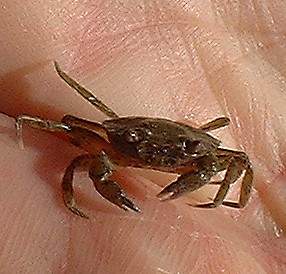 The
mudflats north of the Toll Bridge are dotted
with Lapwings,
poised with heads
into the breeze (hundreds at this time of the year and throughout winter
at low tide). Katherine Hamblett (8)
wondered what might be under the rocks in the soft wet silt,
it soon became clear that almost every rock has at least one small Shore
Crab hiding beneath it.
Lifting items of driftwood and other flotsam above the tideline in the
hope of discovering Slow Worms,
yielded nothing more than hundreds of spring-loaded Sandhoppers
which scatter and vanish as the security of their hideout is breached. The
mudflats north of the Toll Bridge are dotted
with Lapwings,
poised with heads
into the breeze (hundreds at this time of the year and throughout winter
at low tide). Katherine Hamblett (8)
wondered what might be under the rocks in the soft wet silt,
it soon became clear that almost every rock has at least one small Shore
Crab hiding beneath it.
Lifting items of driftwood and other flotsam above the tideline in the
hope of discovering Slow Worms,
yielded nothing more than hundreds of spring-loaded Sandhoppers
which scatter and vanish as the security of their hideout is breached.
2
November 2002
The
capture on rod and line by Peter
Weight (Lancing) of a Boar
Fish, Capros aper,
from Hove beach is the very first record of this fish caught from the shore
off Sussex. The books
say that this fish lives in depths of over 100 metres and there are no
seas of this depth on the English
side of the English Channel.

This
pretty little red and silver
rhomboidal fish about 55 mm long, excluding its caudal fin, large eye and
large protractile mouth, with a spiky first dorsal and vibrating second
dorsal and second anal fins (vibrating like the dorsal fin of a pipefish).
Although this fish is rarely caught, it is abundant in deepish water (on
the edge of the continental shelf in the western approaches of the English
Channel) and it is just that normal fishing methods do not capture this
small fish. All records and especially all live records from the
shore or on dives, and all Sussex records are newsworthy.
This
fish is thriving in the BMLSS private aquarium
(Shoreham-by-Sea). This fish is rarely on display
in British Public Aquaria and the only known display
of this fish was for several years at Mevagissey
Harbour Aquarium.
Previous
Sussex Record of a Boar Fish
Previous
Report from the Channel Islands
BMLSS
Boar Fish
2
November 2002
As
I walked down the old railway track below Partridge Green a couple of small
Roe
Deer were feeding. This was the first
time I have seen deer on the track. (This is the Downs Link). Below Henfield
on the same track a Goldcrest
about
eye height sat in a branch about 2 metres away. I stopped and watched and
the smallest British bird just hopped from branch to branch.
Upper
Adur East (Shermanbury area) Nature Pages

31
October 2002
The
sudden flight of a "little
brown bird" with a glimpse of the white outer
tail feathers but in an unusual place on Lancing beach (flying from Beach
Green to the shingle banks) (TQ 185 037) where
the bird perched on a wooden sea defence structure above high tide level
and I could see the full brown speckled colour of this bird, which is rarely
possibly in the meadows. It looked larger than a sparrow. It was probably
a Meadow Pipit.
(The other uncommon winter visitor pipit on this coast is the Scandinavian
Rock Pipit, noticeable as a Rock Pipit
because of its grey outer tail feathers. It could have been a Water
Pipit.)
Chirms
of 20+ Goldfinches flew
around their usual bushes between Widewater Lagoon
and the sea, and in adjoining bushes, the House
Sparrows made a cacophonic racket as a
Kestrel
flew overhead.
December
2002 Pipit Report
27
October 2002
 Moderate
Gale Force 7 winds
(36 mph at 10:26 am)
gusting to Storm Force 10
(64 mph at 6:36 am),
but not accompanied by heavy rain, blow the trees about. By midday the
wind had reduced to a Fresh Breeze Force 5
(24 mph). Even so, in the early afternoon, the branches of the large trees
in Buckingham Park were waving about, indicative of Force 6. Moderate
Gale Force 7 winds
(36 mph at 10:26 am)
gusting to Storm Force 10
(64 mph at 6:36 am),
but not accompanied by heavy rain, blow the trees about. By midday the
wind had reduced to a Fresh Breeze Force 5
(24 mph). Even so, in the early afternoon, the branches of the large trees
in Buckingham Park were waving about, indicative of Force 6.

Shoreham
Beach Weather
Beaufort
Scale
Weather
Links
24
October 2002
In
recent days I have seen a party of about six Long
tailed Tits, Aegithalos caudatus,
a pair of Blue Tits,
a Great Tit in
my south Lancing garden. Today
a Blackcap,
Sylvia
atricapilla, was seen and probably confirms identity of a sound heard
about a week ago, which when described to an expert, it was suggested as
being from a distressed Blackcap.
The
ripe fruit on the 10 metres high Hawthorn
Tree is one of the attractions for some
of the birds, others like the peanuts hanging from a garden Crab
Apple Tree. An occasional butterfly
passes without pause, today a Red Admiral
went by heading east. (TQ 186 044)
UK
Wildlife Gardening Yahoo Group
Lancing
Nature Nature News (October 2002)
22
October 2002
A
Speckled
Wood Butterfly in good condition was in
my Shermanbury garden.
Also the Greater Spotted Woodpecker
is still making visits to the bird feeder although the red
head has turned to black
and his frontage looks a little dirty.
2001
Woodpecker Report with photograph
20
October 2002
A
Kestrel
was
seen flying over the gardens at the rear of my house in south Lancing about
first floor height. It was lazily pursuing birds which were mostly Starlings,
all of which became very agitated and flew in the opposite direction. (TQ
186 044)
19
October 2002
Six
Small
Tortoiseshell Butterflies were seen between
Beeding
Hill and Truleigh Hill.
A chirm
of over 30 Goldfinches
flocked near the Church of Good Shepherd on Shoreham
beach. A Speckled Wood Butterfly,
faded but mostly intact, fluttered around in Lancing town centre by the
pet shop. On the airport side of the A27 opposite the Sussex Pad, a distinctive
black-blue banded dragonfly hawked about five
metres over the roadside bushes. This was a Migrant
Hawker, Aeshna mixta.
Adur
Dragonflies
2001
Report
18
October 2002
Adur
World Oceans Day meeting
Clubs
and societies are invited to hold an evening Adur
World Oceans Day event.
11
October 2002
A
Robin
singing from the top of a Hawthorn Bush,
on a warm afternoon that felt like spring, if it was not for the red
berries. Also on the cycle path from Old Shoreham
to the disused cement works at Beeding, a Pheasant
crossed my path.
Adur
Levels
Early
in the morning a couple of Butterfish hid
under rocks on the estuarine part of Kingston beach.
9 October
2002
There
was a mallard-sized duck on Kingston Buci beach
(entrance to Shoreham harbour by the lighthouse) at midday, a couple of
hours before the high 6.7 metre spring tide (i.e. very high water). I did
not have my bins and the duck was silhouetted. I had it penned as an Eider
or a Scoter from a distance of about 200 metres. It was just resting on
the flat sea.
The
SOS
consider Eiders Ducks and Scoters to be Winter Visitors (WV) &/or Passage
Migrants (PM), of scarce occurrence except for Common Scoters, which are
fairly common. (Small flocks of Common Scoters
have been observed resting on the sea from Southwick beach in January.)
However,
on 7 October 2002
a female Velvet Scoter
was seen on her own five metres offshore near Shoreham Power Station at
1:06
pm.
Adur Valley
Wildlife Internet Resources
7 October
2002
As
the high tide reached it's peak at around 12:15
pm the percolation effect could clearly be
seen at the western end of the Lagoon. As the rising tide pushes it's way
through from the seaward side, trapped air is expelled. In many places
the along the southern edge of the lagoon air bubbles rapidly rose to the
surface as if the water was boiling. In at least two places, seawater springs
emerged from the lagoon edge. Black and green algal growth clustered around
the slow trickle.
On
the adjacent beach, as the sun shone warmly, the sea was flat enough to
skim pebbles on the surface. The fear of a low pressure weather system
corresponding with an unusual high tide did not materialise.

A Comma
Butterfly patrolled the sheltered leeward
side of the bank while at the top of the bank a Clouded
Yellow Butterfly took advantage of the
clusters of Michaelmas Asters
which also attracted bees to one of the seasons last nectar sources.
Widewater
Page (by Ray Hamblett
Widewater
Images for September 2002 (by Ray Hamblett)
Adur
Butterflies
After
a month of minimal rain and with Indian Summer
summer preceding some of the highest and lowest equinoctial spring tides
for over 20 years, I visited Widewater Lagoon,
1½ hours after the midday high spring tide of 6.8 metres. The bubbles
of percolating seawater had ceased by then and the only water commotion
was caused by a small flock of Ringed Plover.
There was a band of about 40 cm of wet mud (west of the bridge) where it
looked as though the water had recently receded. The lagoon level was higher
than that of a month ago, as the separate westerly lagoon was a continuous
sheet of water, but still scarcely more than a large puddle. There were
thousands of small prawns in the lagoon.
Widewater
Salinity
 6
October 2002 6
October 2002
Approaching
midnight, 11:00 pm,
an urban Fox trotted
across Ham Road in the centre of Shoreham and into the grounds of the Old
Schoolhouse.
With
Indian
Summer summer preceding some of the highest and lowest equinoctial
spring tides for over 20 years was too good a rockpooling
chance to miss as low tide receded to Chart
Datum about 6:00 pm,
just before an attractive red sunset.

The
low tide on Lancing beach revealed shallow
pools and rocks covered in weed, but it was the push-net in shallow water
that provided the most interesting discoveries including an attractive
Little
Cuttlefish,
Sepiola, that squirted
five dollops of ink in the temporary aquarium, and my very first discovery
of the South-claw Hermit Crab,
Diogenes
pugilator, on the Sussex coast.
Full
Report
The
blue
butterfly season is over but this morning there were about ten Small
Tortoiseshell Butterflies and an immigrant
Clouded Yellow up Mill
Hill, where a Wasp Spider,
Argiope
bruennichi, was discovered near its previous location.
Ray
Hamblett's Mill Hill web page (with photographs of spiders and orchids
and other wild plants)
6 October
2002
A
blue butterfly fluttering around the Ivy behind Lancing Library was probably
a third brood Holly Blue Butterfly.
Lancing
Nature Nature News (October 2002)
5 October
2002
Down
the beach this morning to check the sea state for diving when I noticed
I was being watched by a seal, bobbing in front of me. I first saw it in
the surge five metres from the shore, in front of the new sea defence works,
east of the Widewater Lagoon.
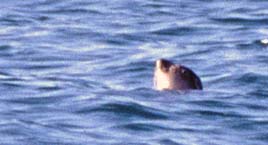
A fisherman
in a boat must have just passed the seal moments before I had arrived,
maybe he gave the seal some titbits?
It
was a Harbour (Common) Seal, Phoca
vitulina, as I have photographed Grey
Seals many times and this seal is different.
Previous
Seal Report 2002
BMLSS
Seals
Seas
off Sussex
Grey
Seal Report 1996
4
October 2002
Although
reported before, today was the first time time I had seen a Little
Egret on Kingston
beach, wading about in a shallow pool on the low neaps, before flying
eastwards to sandy part of the shore. The Little
Egret was preening and it was not seen to
attempt to feed. Under the rocks there were numerous (50+) young Rock
Gobies, about 650 mm long, which would provide a tasty snack for the
long beak of the Egret,
as well as thousands of very small prawns in the shallow pools.
On
the waterline an Oystercatcher
probed, and the bright orange legs of a junior Redshank
contrasted with the dark red legs of the Black-headed
Gulls. A Cormorant
fanned
its wings and there were at least a couple of Great
Black-backed Gulls, but I would be surprised
if they weren't present.
3 October
2002
Warm
sunshine brought out he best of the vivid colour of male Clouded
Yellow Butterfly, Colias croceus,
on vegetated shingle at Shoreham Beach (TQ
210 044) and another at the derelict Ropetackle
site (TQ 212 052).
And a Common Darter Dragonfly,
Sympetrum
striolatum, Common Lizard
and Slow Worms
were seen basking amongst flotsam on the banks of the River Adur (TQ
208 058).
Adur
Butterflies
The
Hedgehog
has
returned to my front garden in Corbyn Crescent, Shoreham.
(TQ
224 053).
A large
jellyfish at least one metre in diameter was spotted in the River Adur
underneath the footbridge at 10:00
am moving seawards, swimming actively with
the ebbing neap tide. It had a milky white bell with a salmon-pink petticoat
and frilly white tentacles. This is probably the Barrel
Jellyfish, Rhizostoma
octopus.
Report
by Hayley Packer
The
common Garden Orb Spider,
Araneus
diadematus, are spinning numerous and extensive webs and it would seem
that the few remaining butterflies would find it it hard not to blunder
into these traps, but there are a few Large Whites and Red
Admirals flying strongly around in Shorehamtown
and Shoreham beach.
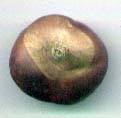
The
conkers on the Horse Chestnut Tree
are attracting the kids, as they successfully throw branches up the tree
to dislodge the conker nuts from the tree on the south side of the road
opposite Lancing Manor.

|

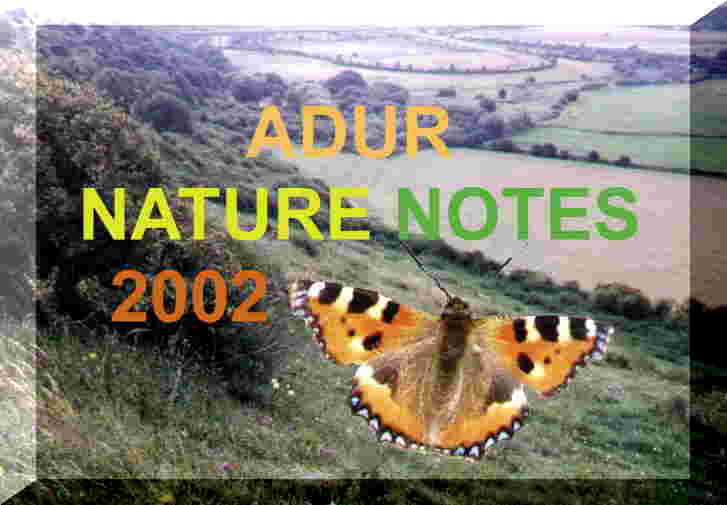


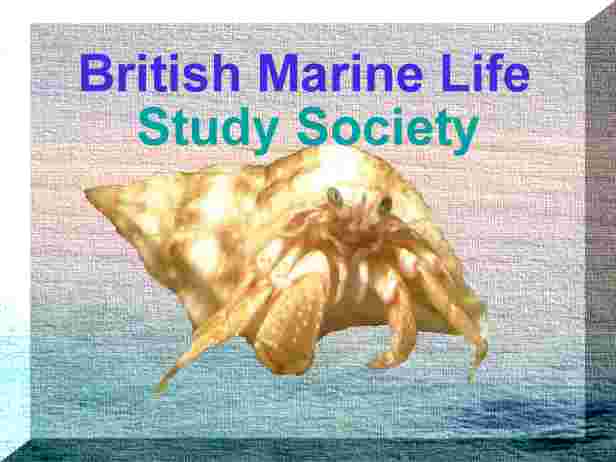
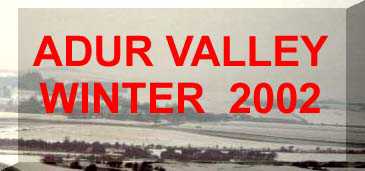



 Hundreds
of gulls filled the air and covered the sodden school playing fields and
green grass of the parks, totalling thousands. It seems that there are
more than usual at this time of the year: Black-headed
Gulls, with striking red legs (probably
a different population than the summer resident gulls) make up the
bulk of the influx, but there were scores, totalling hundreds of Herring
Gulls, both mature and immature. Many
of the gulls were "paddling" for worms. The
mud flats at half tide opposite the airport were denuded of gulls and six
Grey
Plovers were the largest birds, feeding
at the water's edge on a breezy overcast day.
Hundreds
of gulls filled the air and covered the sodden school playing fields and
green grass of the parks, totalling thousands. It seems that there are
more than usual at this time of the year: Black-headed
Gulls, with striking red legs (probably
a different population than the summer resident gulls) make up the
bulk of the influx, but there were scores, totalling hundreds of Herring
Gulls, both mature and immature. Many
of the gulls were "paddling" for worms. The
mud flats at half tide opposite the airport were denuded of gulls and six
Grey
Plovers were the largest birds, feeding
at the water's edge on a breezy overcast day.








